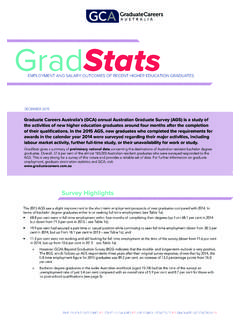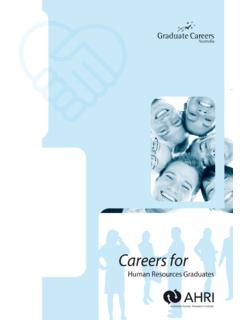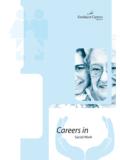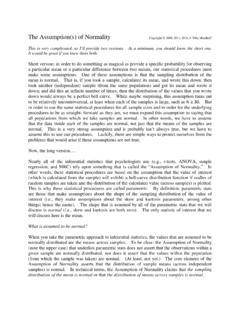Transcription of GradStats - Graduate Careers Australia
1 GradStats February 2018: Page 1 GradStats February 2018 EMPLOYMENT AND SALARY OUTCOMES OF HIGHER EDUCATION GRADUATES FROM 2017 Graduate Careers Australia s (GCA) annual Australian Graduate Survey (AGS) was a study of the activities of new higher education graduates around four months after the completion of their qualifications. Every year since 1976, new graduates who completed the requirements for awards in the preceding year were surveyed regarding their major activities, including labour market engagement, further full-time study, or their unavailability for work or study. With the cessation of Federal Government funding, the AGS concluded after the 2015 survey, with the Quality Indicators for Learning and Teaching (QILT ) suite of surveys replacing it. Over the years, GradStats1 has presented a summary of national AGS data concerning the destinations of Australian resident bachelor degree graduates.
2 This edition will endeavour to provide a summary link between the last AGS figures and the first two tranches of related QILT results. Figures for 2016 and 2017 quoted in this publication largely come from the QILT Graduate Outcomes Survey (GOS) 2016 and 2017 National Reports (which can be downloaded from ). It must be noted that there are a number of ways in which QILT departs from AGS methods and data analysis, and comparisons of results between the two surveys need to be read with that in mind. The 2017 GOS report notes that The 2017 GOS was primarily conducted as a national online survey among 97 higher education institutions [and a] .. total of 120,747 valid survey responses were collected across all study levels, representing a response rate of per cent. 1 Previous editions of GradStats can be downloaded from GradStats February 2018: Page 2 Overview The 2017 GOS report saw a further slight improvement in the short-term employment prospects of new graduates compared with the 2015 AGS and 2016 GOS reports.
3 Per cent were in full-time employment at the time of the 2017 GOS compared with per cent in 2016 (see Fig. 1). This is notably up from per cent in the 2014 AGS (see Fig. 2) The full-time employment figure for males (see Fig. 1) was per cent in 2017 ( per cent in 2016) while for females it was per cent ( per cent in 2016). The overall employment rate for undergraduates was per cent in 2017. This refers to graduates who had any employment (whether full or part time see Fig. 1). Middle- to longer-term employment prospects for undergraduates remain strong. QILT s follow-up longitudinal GOS (GOS-L) showed that three years after a full-time employment rate of per cent in the 2014 AGS, by 2017 this had grown to per cent. GCA s Beyond Graduation Survey (BGS) showed similar improvements in employment figures three years out. Bachelor degree graduates in the wider Australian workforce (aged 15-74) had (at the time of the 2017 GOS) an unemployment rate of just per cent compared with an overall population rate of per cent and per cent for those with no post-school qualifications (see Fig.)
4 3). The median annual starting salary for new Australian resident bachelor degree graduates in full-time employment in Australia was $60,000 in 2017, up from $57,900 in 2016 (see Table 3). Just over one-fifth of respondents ( per cent, down from per cent in 2016), were undertaking further full-time study (see Fig. 5). Overall satisfaction with courses as measured by the Course Experience Questionnaire (CEQ) remains at an elevated level, with per cent of graduates expressing satisfaction with their courses (see Fig. 6). Just over half of the graduates who found full-time employment in 2014 or 2015 learned of their job first through one of three strategies (see Table 4): searching advertisements on the internet ( per cent), talking to family or friends ( per cent) and visiting university or college Careers services ( per cent). Overall, 84 per cent of employers were highly satisfied with the performance of their new recruits.
5 GradStats February 2018: Page 3 Full-time employment The results of the 2017 GOS show that per cent of new bachelor degree graduates seeking full-time employment had found a position by the time of the survey four months after course completion. This was up slightly from the comparable figure of per cent in 2016 and per cent in the 2015 AGS (see Figure 1). The 2017 GOS report notes ( ) that This continues the steady improvement in the full-time employment rate of graduates in recent years from the low point of per cent in 2014. This is consistent with a modest improvement in the overall labour market over the period. Of those graduates available for full-time employment, similar percentages of males and females ( per cent and per cent respectively - see Figures 2 and 3) had found a full-time position by the time of the 2017 survey. The comparative figures from the 2016 GOS were and per cent.
6 The GOS reports also calculate an overall employment rate. This refers to the percentage of all employed graduates (full-time plus part-time or casual employment), as a proportion of those available for any employment. In 2017, the overall employment rate for all graduates was per cent ( per cent for males and per cent for females see Figure 1). AGS figures for 2015 are also presented in Figures 1 and 2, but the 2017 GOS report notes that caution should be used when directly comparing the different series due to changes in survey methodology . Figure 1: Undergraduates in employment, by sex, 2015-7 (%) Sources: 2015 Australian Graduate Survey and 2016-17 Graduate Outcomes Survey Males'15 Females'15 Total '15 Males'16 Females'16 Total '16 Males'17 Females'17 Total '17 Full-time employmentOverall employment GradStats February 2018: Page 4 Figure 2: Undergraduates in full-time employment, by sex, 2013-17 (%) Sources: 2013-15 Australian Graduate Survey and 2016-7 Graduate Outcomes Survey Long-term full-time employment prospects Of additional note regarding the employment prospects of new graduates are longer-term figures, which remain strong.
7 QILT s 2017 follow-up longitudinal GOS (GOS-L) showed that after a full-time employment rate of per cent2 was found in the 2014 AGS, three years later in 2017 this had grown to per cent. GCA s Beyond Graduation Survey (BGS3) showed similar improvements in employment figures three years out. And looking at the wider population, Australian Bureau of Statistics (ABS) figures for May 20174 show that, in the general labour force (aged 15-74), just per cent of bachelor degree graduates were unemployed (see Figure 3). The comparative figure for those with a postgraduate degree was per cent, and for those with a Graduate or postgraduate diploma it was per cent. For the total population (with or without non-school qualifications), the unemployment rate was per cent and per cent for persons with no post-secondary qualifications. Longer-term prospects for those with higher education qualifications remain very positive.
8 2 This was re-calculated by QILT for the GOS-L report. The 2014 AGS reported per cent, as shown in Figure 2 in this document. 3 Download the BGS report from: 4 ABS, 2017, Education and Work, Australia , May 2017, (Table 10), Canberra. GradStats February 2018: Page 5 Figure 3: Unemployment rates by level of educational attainment, May 2017, Australian labour force aged 15-74 Source: Education and Work, Australia , May 2017, Australian Bureau of Statistics, publication , released 6 November 2017 (Table 10) Part-time employment As in the general population, part-time employment is an important option for some new graduates, with females more likely to be in such. The 2017 GOS report notes that per cent of all employed new graduates were working on a part-time basis ( per cent for females and per cent for males see Figure 4).
9 Of those in any employment at the time of the 2017 GOS, per cent were working part time and seeking more hours. Females ( per cent) were also more likely than males ( per cent) to be seeking more hours (defined as involuntary part-timers in the 2016 GOS report). A further per cent were in part-time work and not seeking additional hours (described as voluntary part-timers in the 2016 GOS report). As with involuntary part-time work, females were more likely than males to be in voluntary part-time employment ( per cent and per cent respectively). While reliable comparisons with the old AGS categories are not possible based on the published data, this voluntary category would broadly coincide with the working part-time, not seeking full-time AGS category while the involuntary group would seem to coincide with those working part-time, and seeking full-time.
10 DegreeGraduate diploma/certificateBachelor degreeNo post-secondary qualificationTOTALP ostgraduatedegreeGraduatediploma/certifi cateBachelor degreeNo post-secondaryqualificationTOTAL% Unemployed GradStats February 2018: Page 6 In the 2017 GOS (Table 5 in that report), graduates from the fields of creative arts communications psychology tourism, hospitality, personal services, humanities, culture and social sciences science and mathematics health services and support were more than five percentage points above the overall average of per cent of employed graduates in involuntary part-time positions and thus seeking more hours. Table 6 in that report reveals that slightly more than half of involuntary part-time employment ( per cent) was based on labour market factors, and this figure was made up largely of per cent who had not been able to find a suitable job in their area of expertise and per cent who were unable to find a job with a suitable number of hours.










